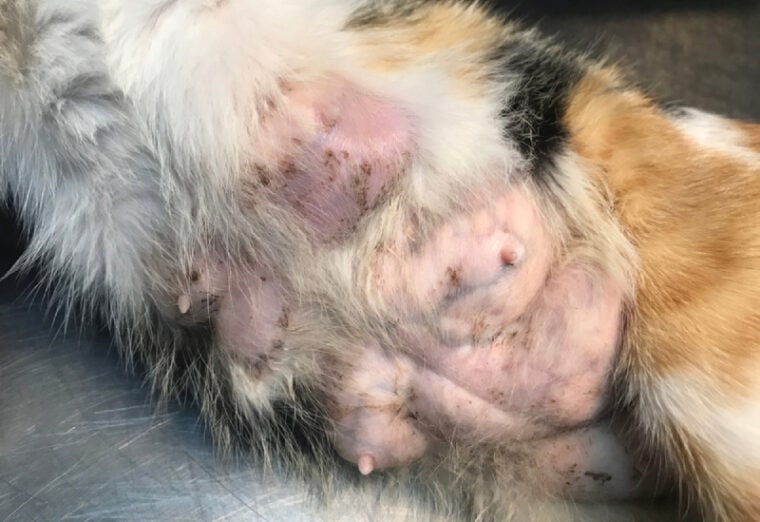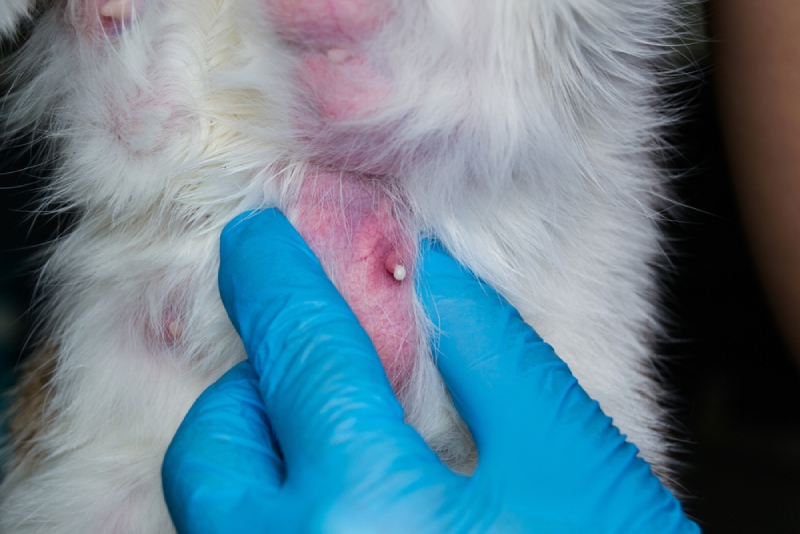
Click to Skip Ahead
Mastitis in cats is an uncommonly seen ailment. The name “mastitis” literally means inflammation of the mammary gland. There are various causes however in cats, it is usually associated with a bacterial infection.
Cats have between 6 and 8 nipples, and mastitis can affect one singular mammary gland or several at once. Mastitis occurs when one or more of the mammary glands become inflamed. It is usually seen in female cats that are nursing a litter of kittens, or a cat that has recently given birth. It can also be seen when the mother weans the kittens when her milk is drying up. If left untreated, mastitis can cause serious health issues and can even result in death.
Fortunately, if identified promptly, with the correct treatment administered, a full recovery is usually seen
What Is Mastitis in Cats?
Mastitis is the name given to a condition where inflammation of the mammary gland (the breast tissue) occurs. Usually in cats, it is associated with a bacterial infection. If the queen is lactating and feeding a litter, the kittens can bite the nipples and cause trauma. This allows bacteria to enter the body, traveling into the mammary gland and establishing an infection. A bacterial infection can occur even if there is no trauma to the nipple if the cat is living in a dirty environment with lots of bacteria present.
Usually, the queen would be able to fight off the infection, but if she is exposed to prolonged stressors, or if she is lacking good nutrition her immune system may not be functioning at its best, and an infection becomes established.
Cats can experience mastitis without there being an infection present. This can come about from blunt trauma to the mammary tissue, or if the cat is nursing but suddenly doesn’t feed for a long period of time. This results in the milk building up excessively in the gland and can cause mastitis.

What Are the Signs of Mastitis in Cats?
Symptoms of mastitis in cats can appear very subtly at first. It is easy to miss them all together at the start, especially if the queen is nursing as some of the signs can be seen with lactating cats such as swollen or engorged mammary glands.
Cats with mastitis may not show systemic signs of illness initially, but if the infection is left untreated things can progress. You may see physical changes in the milk such as pus or blood present. It may change consistency and become thicker and lumpy. In severe cases, abscesses and ulceration can occur. There may be a drainage tract present, which can be exceptionally painful.
What Are the Causes of Mastitis in Cats?
Cats can experience two different types of mastitis. These are classified as septic and non-septic.
Septic mastitis relates to the infection of the mammary glands with bacteria.
The bacteria gain access to the mammary tissue through either direct contact from wounds to the gland, or from other sites of infection in the body where the bacteria are spread via the blood. Unsanitary living conditions and poor hygiene massively increase the risk of infection. The more bacteria present in the cat’s environment, the greater the chances of infection becoming established.
Non-septic mastitis occurs when the mammary glands are inflamed but in the absence of bacteria.
This can occur with injuries or damage to the mammary glands. This usually affects nursing queens when they are producing milk and for one reason or another, the removal of the milk is halted. For example, if the kittens are suddenly weaned or if kittens pass away. The mammary glands continue to produce milk, but the milk isn’t being removed, so the milk builds up and causes the glands to become engorged and swollen.
Mammary hyperplasia can occur prior to mastitis. When a cat ovulates, progesterone is produced by her ovaries which sometimes causes enlargement of the mammary glands. The skin can become stretched and damaged which can lead to infection.
Mammary tumors can also contribute to the development of mastitis if there is a disruption to the normal anatomy of the glands.
Diagnosis of Mastitis in Cats
Your vet will carry out a thorough physical exam as well as take note of the clinical history.
Your vet will most likely want to carry out some tests, these include:
How Do I Care for a Cat with Mastitis

Treatment for mastitis in cats depends on the underlying cause. If there has been a bacterial infection identified, antibiotics will be selected based on culture and sensitivity testing and a course will be prescribed for your cat.
If your cat is lactating, as the antibiotics will be passed through the milk to the kittens, there are certain antibiotics that cannot be used as they are not safe for use in young kittens.
If an abscess develops, your vet may need to perform surgery to lance and drain the abscess to remove the pus. Whether bacteria are involved or not, pain relief is usually always given as the inflammation process causes a great deal of discomfort and pain.
Other treatment involves attempting to make your cat more comfortable, which includes placing warm compresses on the affected area regularly throughout the day and night. If your cat will tolerate it, you can hand express some of the milk away to help decrease the swelling and engorgement. It also increases blood flow to the area and encourages healing.
Cabbage leaf compresses can be used to reduce the pain and degree of inflammation. If your cat will tolerate it, you can secure the leaves in place with a bandage.
Frequently Asked Questions (FAQs)
Can you prevent mastitis in cats?
It is not possible to prevent mastitis. However, there are ways you can reduce the risk of mastitis for your cat. Ensure their environment is kept clean and dry. Change their bedding regularly and clean up urine or feces in the nursing box. Ensure kittens are feeding from all teats and know early signs of mastitis to watch out for. Attempt to wean the kittens off the queen slowly over a few weeks, and avoid any sudden weaning.
Can mastitis in cats go away on its own?
Very mild cases of mastitis, without bacterial involvement, can resolve without intervention. If there is a bacterial infection, or if it is a severe case, it is unlikely to resolve without medication and supportive therapy.
Is mastitis painful for cats?
Mastitis can be an extremely painful and debilitating condition for cats. Inflammation causes pain and swelling. If there is an infection present this exacerbates the inflammation. Cats can suffer hugely and become very sick with mastitis. Pain relief is nearly always given by vets if mastitis is diagnosed.
Conclusion
Mastitis is not commonly seen in cats. Most cases have a very good prognosis if identified early and managed correctly. However, in severe cases, the infection can progress to septicemia. These cases carry a much more guarded prognosis.
Featured Image Credit: M. Sam, Shutterstock







